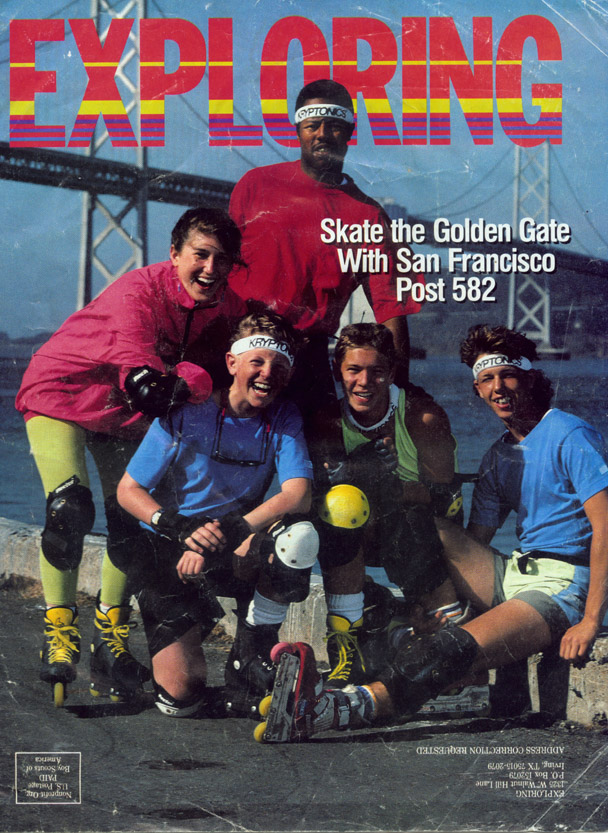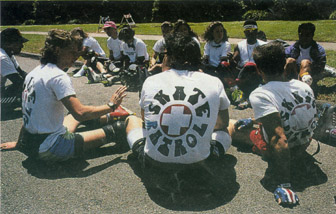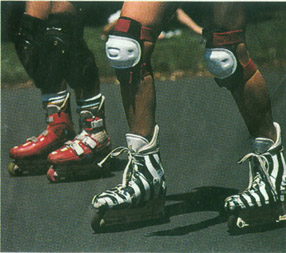 |
| Before there was a National Skate Patrol and before there was an IISA, the Golden Gate Skate Patrol was takin' care of business helping skaters in Goilden Gate Park. This is a cover story article from the National Boy Scouts of America Magazine, 1990 |
 |
Golden Gate Skaters BY SCOU DANIELS It's a perfect Sunday afternoon in San Francisco's Golden Gate Park, a 1,000-acre urban greenbelt laden with gardens, lakes, tennis courts, and a science museum. Hundreds of Bay Area residents, lured by sunny spring skies and cool Pacific breezes, throng to the park's John F. Kennedy Or. to jog, bicycle, and roller skate. |
|
|
Near the intersection of Sixth Ave. and Fulton,.the hip-pop, rap sounds of radio station
KMEL blare from a stereo rigged inside of a portable wooden crate with a car battery
providing electricity. Tall elm trees shade a blacktopped enclave where more than a dozen
skaters practice their stunts and dance to the music.
Suddenly someone yells, "Hey, it looks like trouble up the street!" Five people with the words "Skate Patrol" emblazoned on their T-shirts leave the music at once and race up JFK to the scene of a skater-cyclist collision. The skater is bleeding and showing signs of shock. The bicycler, who ran into and then fell on top of the skater, is shaken but not hurt. A bystander calls 911. Members of the Skate Patrol, also known as Explorer Post 582, keep a curious crowd from getting too close and comfort the skater until an ambulance arrives. They shade his eyes from the sun, cover him with a blanket, and offer him a sip of water. Soon paramedics are on the scene and they begin checking for possible broken bones. Post 582's Skate Patrol works much like a ski patrol. Explorers divide into five-person teams and take 60-minute shifts touring through the park. Each person is trained in basic first aid and certified in CPR. |
 Post 582 Explorers plan a petition drive to limit
Saturday traftic in Golden Gate Park. Post 582 Explorers plan a petition drive to limit
Saturday traftic in Golden Gate Park. |
Accidents
that require outside medical assistance, such as the biker-skater collision, aren't nearly
as common as finding people who take a tumble and wind up with skinned knees and elbows.
"If we find someone who's fallen, we pick them up, dust them off, and reassure them that they're going to be all right," said 15-year-old Anthony Mazzei. "Each of us wears afanny pack that contains adhesive bandages and antiseptic wipes." Anthony, who has been a member of the Explorer post for six months, joined the group after he rented a pair |
| of skates near the park and saw the post in
action. Now he skates there every day. "I live about three miles from the park, and I
skate to and from the post meetings," he said. The Explorers meet on Sundays because that's when the park is closed to automobile traffic and the major thoroughfares teem with recreationists. From 11 until noon, the Explorers conduct an informal skate clinic for people just getting started in the sport. "We give people pointers on the right way to skate rather than let them learn bad habits that they later have to break," said Mike Riddle, 17. One of the worst things a new skater can do is to have too straight of a posture, Mike said. |
"New skaters often get tense and stand up straight," he said. "To skate well, you have to bend your legs and keep your weight forward. We also teach people how to push off to the side so they don't drag their feet." "One of the clinic's most often asked questions is 'How do you stop?'" said Sean Whitley. "We'll show people how to do a T stop or slow themselves down by dragging their foot," he said. "You can also stop pretty well by skating into a semicircle." At noon the Explorers have a 30-minute post meeting to discuss business items such as the upcoming race events sponsored by the Outdoor Roller Skating Association (ORA). |
 |
Today, post Advisor David Miles encourages the group to circulate petitions that ask the San Francisco Park and Recreation Board to extend the park's ban on automobile traffic to Saturdays. At 12:30 the skate patrols begin and continue until 6. "We'll probably skate six or seven miles during a patrol," Mike Riddle said. "That adds up to about 20 or 30 miles during a Sunday in the park. "Skating is my main form of transportation," Mike said. "I don't take the bus anymore because I can go everywhere on skates. It's often faster than the traffic."Skating long distances is nothing new for Mike. Last spring he and several other members of the ORA skated from San Francisco to Los Angeles, a |
 Post 582's skate patrol administers first aid to the
victim of a biker-skater c'ollision in Golden Gate Park. Post 582's skate patrol administers first aid to the
victim of a biker-skater c'ollision in Golden Gate Park. |
distance
of 420 miles. The group organized the trip to demonstrate their stand against crack
cocaine drug abuse.
"It took us 49 hours and 21 minutes," said Mike. "We had four groups of skaters and two RVs. Each group rotated skating-one hour on the road, three hours in the RV. The hardest part of the trip came around Santa Cruz where "we had to skate up a mountain for 11/2 hours.But then we got to go downhill and the RV clocked my speed at 55 miles per hour." |
Such long-distance skating requires hours of training, and San Francisco, known for its steep hills, provides a good workout for both legs and lungs. "I keep in training by skating at least an hour and a half every day," Mike says. "Broadway up to Coit Tower is one of the steepest streets in San Francisco, and I've skated up it. I think it's steeper than the cable car routes. It's about a 45-degree angle." If you're into racing or long-distance skating, Post 582's Explorers recommend you try inline, rather than conventional, skates. Inline skates, sometimes referred to as blades, resemble ice skates with four lightweight polyurethane wheels set in a straight line and attached to a hard plastic boot. Conventional skates have four wheels that are paired two in front and two in back. Both types of skates start at about $150 a pair. Add to that the cost of protective body gear. "Everyone falls once in a while, even the real good guys," says Sean Whitley. "And when you fall you need pads because you can really mess up your knees or break your wrist. That's why we have the wrist guards. Some people, especially those just starting out, also wear elbow pads. "With skates and pads, it will cost you about $225 to $250 to get started," he said. David Miles is Post 582's Advisor and the driving force behind the Golden Gate Park skate patrol. He and the post have earned praise and recognition. "A few years ago, roller skating was nearly out of control in the park" says Joel Robinson, Superintendent of Recreation for the city of San Francisco. "David Miles helped put some controls in place and with creation of the skate patrol he heightened skaters' awareness of safety," Robinson said. Nationally, blade skating has experienced tremendous growth in the last six years. Rollerblade, the dominant manufacturer of inline skates, estimates the number of blade skaters has increased from 40,000 in 1984 to 450,000 today. "The original Rollerblade was invented in 1980 for hockey players as an off-season training device," explains Rollerblade spokesperson Mary Haugen. Indeed, both Sean Whitely and Mike Riddle began their skating adventures long ago on the hockey rink. So how does blade skating differ from ice-skating? Sean has a quick answer: "At an ice-skating rink you have walls. But in rollerblading you have no boundaries. The whole world is your ice-skating rink." |